

Major gene discovery for Arizona, California lettuce industries. A team of researchers, led by a University of California, Davis, plant scientist, has identified a lettuce gene and related enzyme that put the brakes on germination during hot weather — a discovery that could lead to lettuces that can sprout year-round, even at high temperatures.
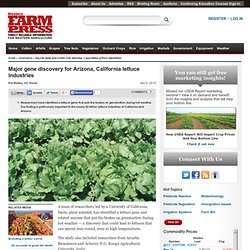
The study also included researchers from Arcadia Biosciences and Acharya N.G. Ranga Agricultural University, India. Breakthough in wheat breeding science offers greater yields. UK wheat yields could be boosted by up to 30% with the introduction of a new wheat bred from a wild grass species.
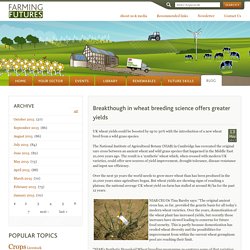
The National Institute of Agricultural Botany (NIAB) in Cambridge has recreated the original rare cross between an ancient wheat and wild grass species that happened in the Middle East 10,000 years ago. The result is a ‘synthetic’ wheat which, when crossed with modern UK varieties, could offer new sources of yield improvement, drought tolerance, disease resistance and input use efficiency. Over the next 50 years the world needs to grow more wheat than has been produced in the 10,000 years since agriculture began.
But wheat yields are showing signs of reaching a plateau; the national average UK wheat yield on-farm has stalled at around 8t/ha for the past 12 years. NIAB CEO Dr Tina Barsby says: “The original ancient cross has, so far, provided the genetic basis for all today’s modern wheat varieties. Note - Synthetic hexaploid wheat T Taken from a NIAB News release www.niab.com. Cambridge-based scientists develop 'superwheat' 11 May 2013Last updated at 20:52 ET.
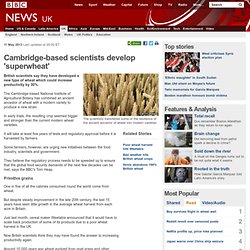
An international vision for wheat improvement. By 2050, a 60% increase in wheat production will be needed to meet the demand of a growing population.
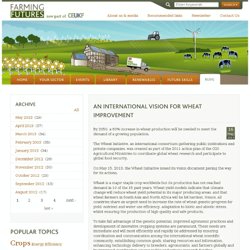
The Wheat Initiative, an international consortium gathering public institutions and private companies, was created as part of the 2011 action plan of the G20 Agricultural Ministries to coordinate global wheat research and participate to global food security. On May 15, 2013, the Wheat Initiative issued its vision document paving the way for its actions. Wheat is a major staple crop worldwide but its production has not reached demand in 10 of the 15 past years. Wheat yield models indicate that climate change will reduce wheat yield potential in its major producing areas, and that wheat farmers in South Asia and North Africa will be hit hardest. Hence, all countries share an urgent need to increase the rate of wheat genetic progress for yield, nutrient and water use efficiency, adaptation to biotic and abiotic stress, whilst ensuring the production of high quality and safe products.
Fertilizer Deep Placement Technology: A Useful Tool in Food Security Improvement. Three billion people depend on rice as a staple food crop, and it is cultivated in over 100 countries on 6 continents.
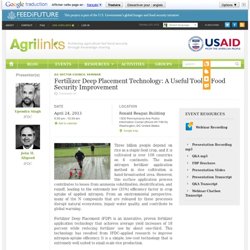
The main nitrogen fertilizer application method in rice cultivation is hand-broadcasted urea. However, this surface application process contributes to losses from ammonia volatilization, denitrification, and runoff, leading to the extremely low (35%) efficiency factor in crop uptake of applied nitrogen. From an environmental perspective, many of the N compounds that are released by these processes disrupt natural ecosystems, impair water quality, and contribute to global warming. Fertilizer Deep Placement (FDP) is an innovative, proven fertilizer application technology that achieves average yield increases of 18 percent while reducing fertilizer use by about one-third.
This technology has resulted from IFDC-applied research to improve nitrogen-uptake efficiency. Egyptian aquaculture: Farming tilapia, mullet and carp in the Nile Delta. The Fish, by Vasile Dobrian (via Wikipaintings).

Within the CGIAR Research Program on Livestock and Fish and embedded within a project on aquaculture development funded by the Swiss Agency for Development and Cooperation (SDC), IEIDEAS — ‘Improving Employment and Income through the Development of Egypt’s Aquaculture Sector’ — is a project implemented by CARE and WorldFish to secure a sustainable future for at least 100,000 people by upgrading Egypt’s aquaculture value chain.
A national ‘innovation platform’ (IP) event was organized by staff of WorldFish, the Netherlands Royal Tropical Institute (KIT) and the International Livestock Research Institute (ILRI). Following the launch of the IP on 12 Jan 2014 and five local (governorate) level workshops (two in Kafr-El-Sheikh and one each in Fayoum, Behera and Sharkia), the national event was held in Cairo in February 2014. A report on this has just been published. Revolutionary Technology Allows Crops to Harvest Nitrogen From the Air Instead of Fertilizers. Photo via Shutterstock Have you ever thought of air as the ultimate crop fertilizer?

We haven’t either, but researchers at the University of Nottingham have developed a technology—termed nitrogen fixation—that allows plant to take nitrogen directly from the air. A special bacteria takes up nitrogen from the air and applies it to plant seeds as coating, enabling each plant cell to spontaneously ‘fix’ nitrogen. The new technology could be commercially available within the next couple of years and it has the potential to replace environmentally damaging fertilizers. The nitrogen fixation process allows plants to convert nitrogen into ammonia. Professor Cocking says the process is not genetic modification nor bio-engineering. The N-Fix technology has of great importance for agriculture, claims Dr Susan Huxtable, Director of Intellectual Property Commercialization at The University of Nottingham.
. + Azotic Technologies Ltd.